ZEN MESTEREK ZEN MASTERS
« Zen főoldal
« vissza a Terebess Online nyitólapjára
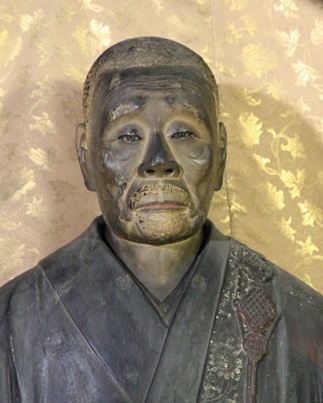
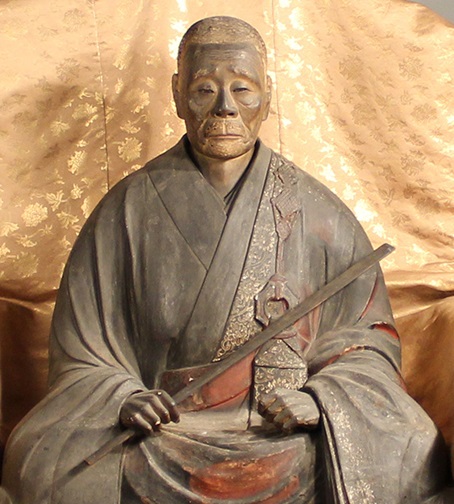
一休宗純 Ikkyū Sōjun (1394-1481)
骸骨
(Rōmaji:) Gaikotsu
written in 1457
(English:) Skeletons
(Magyar:) Csontváz–dalocskák* / Csontváz-nép**
*© Bánfalvi András **©Terebess Gábor
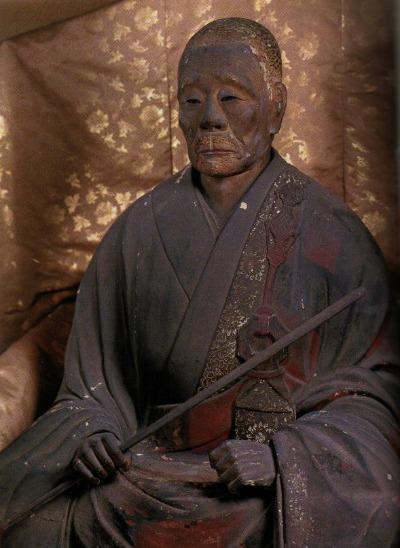
木像 mokuzō; wooden effigy of Ikkyū, 1491
酬恩庵 Shūon-an in Takigi (Tanabe, Kyoto Prefect.)
Tartalom |
Contents |
Ikkjú, névváltozat: Ikkjú Szódzsun (japánul: 一休宗純, Hepburn-átírással: Ikkyū Sōjun) (1394–1481), a rinzai szektához tartozó zen buddhista szerzetes, költő, a japán teaszertartás egyik megteremtője. Gy. Horváth László. Japán kulturális lexikon. Corvina. 1999
John Stevens: Ikkjú Szódzsun Kiliti Joruto: Ikkjú [Legendák Ikkjú életéből] Bakonyi Berta: Másotok sincs... Oravecz Imre: Szerzetes a bordélyban
Terebess Gábor: Ikkjú dókáiból, búcsúverse PDF: Csontváz–dalocskák
狂雲集 Kyōunshū = Kerge Felhő összegyűjtött versei 道歌 Dōka = Tanköltemények
PDF: La saveur du zen: poèmes et sermons d'Ikkyû et de ses disciples |
道歌 Dōka
狂雲集 Kyōunshū / Crazy Cloud Anthology
仏鬼軍 Bukkigun
阿弥陀裸物語 Amida hadaka monogatari
自戒集 Jikaishū 摩訶般若波羅蜜多心経解 Maka hannya haramitta shingyō kai Ikkyu: Zen Eccentric PDF: Zen Radicals, Rebels and Reformers |
Ikkyū gaikotsu 一休骸骨
Woodblock edition of 1692. Illustrated pages only. Drawings attributed to Ikkyū himself.
http://www.wul.waseda.ac.jp/kotenseki/html/ha05/ha05_03711/index.html
http://archive.wul.waseda.ac.jp/kosho/ha05/ha05_03711/ha05_03711.html
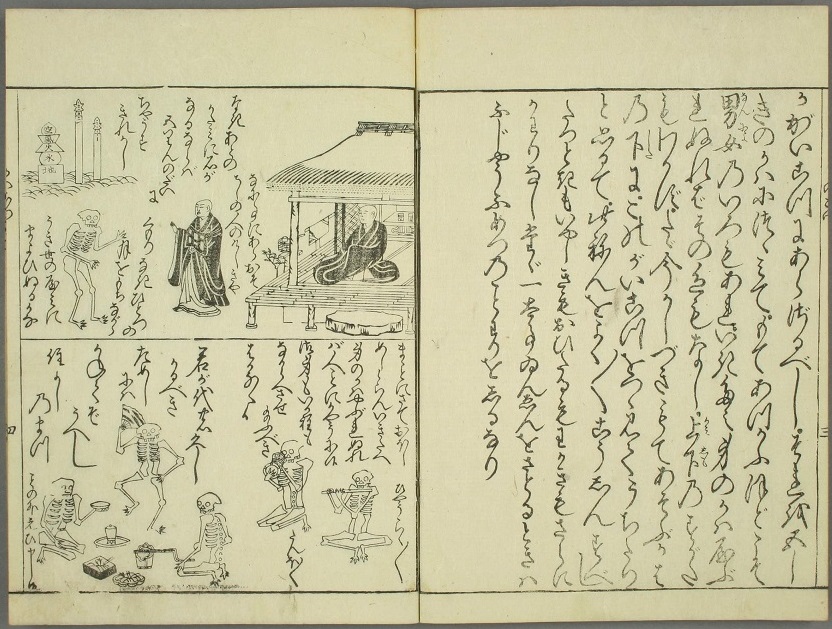
|
1. "One of the skeletons came over to me." 2. Acting their roles, just as in the world of men. |
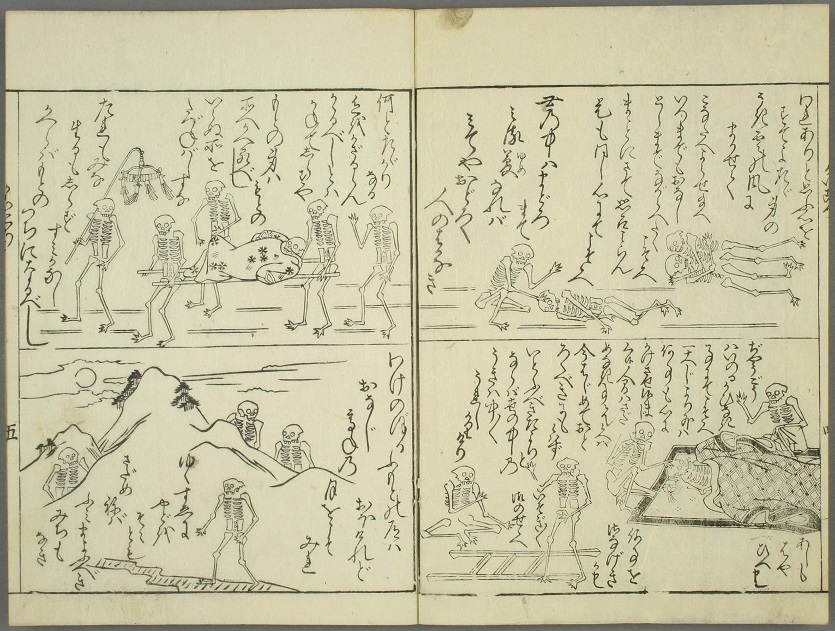
|
5. Homeward bound. 6. "Above the foothills, a single moon." |
3. "Skeletons... patterned into two sexes." 4. Man's evanescence should be no surprise. |
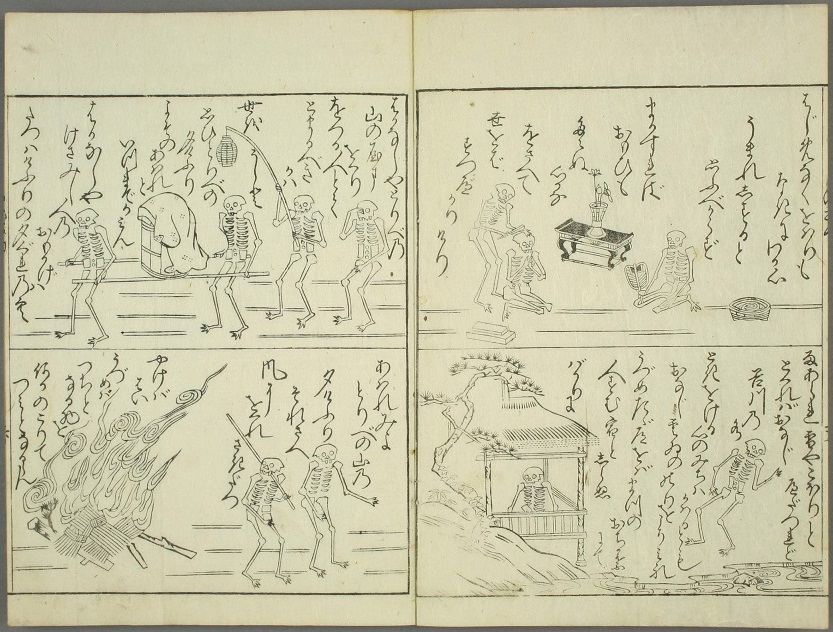
|
9. Mourners: the dead carrying the dead. 10. Loving memories turn to smoke. |
7. Tonsure: "Lay the world aside." 8. "Fallen pine needles bury the way." |
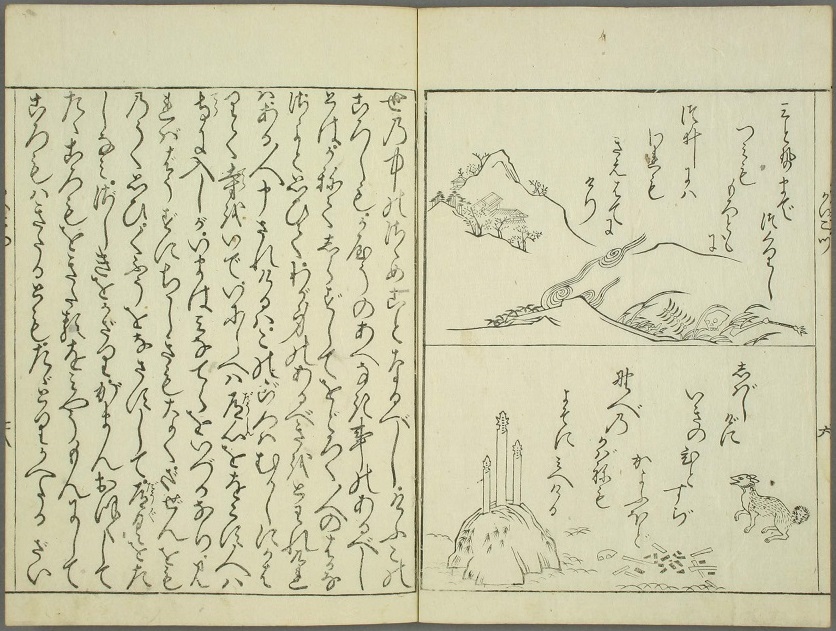
|
11. Even "I" fades in the end. 12. Unknown corpses are viewed without concern. |
Ikkyū’s Skeletons*
Ch. 6. in The Buddha Eye: An Anthology of the Kyoto School and Its Contemporaries, edited by Frederick Franck, World Wisdom, Inc, 2004, pp. 69-79.
*Originally published as “Ikkyū's Skeletons,” trans. R. H. Blyth & N. A. Waddell, The Eastern Buddhist, N. S. Vol. VI. No. 1 (May 1973), pp. 111-125.
The late R. H. Blyth called Ikkyū (1394-1481) “the most remarkable monk
in the history of Japanese Buddhism, the only Japanese comparable to the
great Chinese Zen masters.” This makes it all the more regrettable he did
not live to translate more of Ikkyū’s writings for Western readers beyond
the brief glimpse afforded in the Buddhist verse, the dōka or “Way poems,”
which appeared in the fifth volume of his Zen and Zen Classics. When Dr.
Blyth died in 1962, he left fragmentary translations of several of Ikkyū’s
kana hōgo (easy Buddhist sermons in the vernacular) and a nearly complete
manuscript translation of the Skeletons, perhaps for a book he had
planned. The manuscript of the Skeletons is the basis for the present translation.
It is probably the first of Ikkyū’s prose writings to be published when
he was already in his sixties, just a few years before the great love affair of
his life was to scandalize Kyoto’s clerical world, and almost two decades
before he would end his career as abbot of Daitokuji.
The few facts of Ikkyū Zenji’s life that need to be recalled in introducing
this translation may be found in Blyth’s essay on Ikkyū in Zen and Zen
Classics.
The editor of this section, Professor N. A. Waddell, lecturer in
International Studies, Otani University, writes:
Introduction
Ikkyū’s Skeletons, timeless as they are, will be more easily understood
when placed in the historical context in which they belong.
A hundred and fifty years prior to Ikkyū’s birth, the priest
Nichiren (1222-82) in his Risshō ankoku ron painted a picture of the
social unrest of Kamakura times in which he tells of earthquakes,
fires, famines, and epidemics, and describes streets cluttered with
corpses, skeletons, and the carcasses of animals. Ikkyū’s times were
not any better. The records show that throughout the Muromachi
period such horrors were quite common, often aggravated by riots
and feudal warfare. During the frightful Ōnin civil war, Kyoto with
its palaces and temples was reduced to ashes. In the uncertainties
and catastrophes of the fifteenth century, the upper classes often
had to flee to the countryside for shelter. The remaining townspeople
lived constantly on the brink of anarchy: governmental and
religious authority had broken down. This was the environment in
which Ikkyū passed his entire life. The Ōnin war began in 1467 and
ended in 1477, four years before his death.
Strangely, vigorous cultural activity continued during the
Ashikaga Shōguns’ rule, notwithstanding all the turmoil. It
reached new heights after 1450, in the period of the Higashiayama
culture, which centered around the Silver Pavilion, built by
Ashikaga Yoshimasa (1435-90), a lavish patron of the arts.
The Skeletons seems to have been first printed in 1457 when
Ikkyū was sixty-three years old, and became in the course of time
known by the popular title Ikkyū’s Gaikotsu. It is written partly in
prose and partly in verse, and falls naturally into three sections.
The first is mainly prose, with a few poems scattered at intervals,
the middle portion a series of poems (dōka, Buddhist waka) with
illustrations, and the third, once more, is mostly prose. The illustrations
of skeletons and groups of skeletons engaged in various
human occupations which illuminate the central section are imaginative,
humorous, but at the same time allegorical and didactic.
The earliest extant edition of the work is undated, but it is
believed to belong to the Muromachi period (1338-1573).
Whether it was actually published during Ikkyū’s lifetime is
unknown. It is presumed to be a reproduction of an illustrated
manuscript by Ikkyū himself. Both the calligraphy and the illustrations
strongly suggest it is indeed his creation. Another printing,
from the original woodblocks, or perhaps a facsimile, was apparently
made in the early seventeenth century. A photo-facsimile of
an undated edition ascribed to the Muromachi period was published
in a reduced-size, limited edition by Ryukoku University,
Kyoto, in 1924. During the Tokugawa period (1603-1867) two or
three other editions appeared, all showing important textual variations
from earlier ones. Their illustrations are similar in format
but different in artistic conception, and not to be compared to the
delightful drawings which are reputedly Ikkyū’s own.
The translator used the text of a modern edition for his translation,
based on the later woodblock versions that show considerable
variance from the earlier text. I have not indicated these
variants, but merely want to draw attention to them.
Dr. Blyth’s manuscript dates from the mid-1950s or earlier. A
portion of the prose text and a few of the poems scattered
throughout the work are missing. In preparing it for publication,
editorial revisions and footnotes have been kept to a minimum. In
order to present a complete translation I have translated the portions
of the text left unfinished by Dr. Blyth. Notes 7 and 8 are
Blyth’s; the rest are mine.N. A. Waddell
Ikkyū’s Skeletons (Text)
The myriad Laws are seen written in thin India ink.[1] But the beginner
must do zazen earnestly. Then he will realize that there is nothing
born into this world which will not eventually become “empty.”
Oneself and the original face of heaven and earth and all the world
are equally empty. All things emerge from the “emptiness.” Being
formless it is called “Buddha.” The Mind of Buddha, the
Buddhahood, the Buddha in our minds, Buddhas, Patriarchs, and
Gods are different names of this “emptiness,” and should you not
realize this you have fallen into the Hell of ignorance and false
imagination. According to the teaching of an enlightened man, the
way of no return[2] is the separation from Hell and rebirth, and the
thought of so many people, whether related to me or not, passing
through reincarnations one after another, made me so melancholy,
I left my native place and wandered off at random.
I came to a small lonely temple. It was evening, when dew and
tears wet one’s sleeves, and I was looking here and there for a place
to sleep, but there was none. It was far from the highway, at the foot
of a mountain, what seemed a Samadhi Plain. Graves were many,
and from behind the Buddha Hall there appeared a most miserable-
looking skeleton, which uttered the following words:
The autumn wind
Has begun to blow in this world;
Should the pampas grass invite me,
I will go to the moor,
I will go to the mountain.What to do
With the mind of a man
Who should purify himself
Within the black garment,
But simply passes life by.
All things must at some time become nought, that is, return to
their original reality. When we sit facing the wall doing zazen, we
realize that none of the thoughts that arise in our minds, as a result
of karma, are real. The Buddha’s fifty years of teaching are meaningless.
The mistake comes from not knowing what the mind is.
Musing that few indeed experience this agony, I entered the
Buddha Hall and spent the night there, feeling more lonely than
usual, and being unable to sleep. Towards dawn, I dozed off, and in
my dream I went to the back of the temple, where many skeletons
were assembled, each moving in his own special way just as they did
in life. While I marveled at the sight, one of the skeletons
approached me and said:
Memories
There are none:
When they depart,
All is a dream;
My life—how sad!If Buddhism
Is divided into Gods
And Buddhas;
How can one enter
The Way of Truth?For as long as you breathe
A mere breath of air,
A dead body
At the side of the road
Seems something apart from you.
Well, we enjoyed ourselves together, the skeleton and I, and that
illusive mind which generally separates us from others gradually left
me. The skeleton that had accompanied me all this while possessed
the mind that renounces the world and seeks for truth. Dwelling on
the watershed of things, he passed from shallow to deep, and made
me realize the origin of my own mind. What was in my ears was the
sighing of the wind in the pine trees; what shone in my eyes was the
moon that enlightened my pillow.
But when is it not a dream? Who is not a skeleton? It is just
because human beings are covered with skins of varying colors that
sexual passion between men and women comes to exist. When the
breathing stops and the skin of the body is broken there is no more
form, no higher and lower. You must realize that what we now have
and touch as we stand here is the skin covering our skeleton. Think
deeply about this fact. High and low, young and old—there is no difference
whatever between them. When we are enlightened concerning
the One Great Causality we understand the meaning of
unborn, undying.
If a stone
Can be the memento
Of the dead,
Then the tombstone
Would be better as a lavatory.
How dangerously foolish is the mind of man!
We have
One moon,
Clear and unclouded,
Yet are lost in the darkness
Of this fleeting world.
Think now, when your breath stops and the skin of your body
breaks, you will also become like me. How long do you think you
will live in this fleeting world?
To prove
His reign
Is eternal,
The Emperor has planted
The pine trees of Sumiyoshi.[3]
Give up the idea “I exist.” Just let your body be blown along by
the wind of the floating clouds; rely on this. To want to live forever
is to wish for the impossible, the unreal, like the idea “I exist.”
This world
Is a dream
Seen while awake;
How pitiful those
Who see it and are shocked!
It is useless to pray to the gods about your destiny. Think only of
the One Great Matter.[4] Human beings are mortal; there is nothing
to be shocked about.
If they can serve
To bring us to loathe them,
The troubles of this world
Are most welcome.Why on earth
Do people decorate
This temporary manifestation,
When from the first they know
It will be like this?[5]The body of a thing
Will return
To the Original Place.
Do not search,
Unnecessarily, elsewhere.Not a single soul
Knows why he is born,
Or his real dwelling place;
We go back to our origin,
We become earth again.Many indeed
The ways to climb
From the mountain foot,
But it is the same moon
That we see o’er the peak.If I do not decide
The dwelling place
Of my future,
How is it possible
That I should lose my way?Our real mind
Has no beginning,
No end;
Do not fancy
That we are born, and die.If you give rein to it,
The mind goes rampant!
It must be mastered
And the world itself rejected.Rain, hail and snow,
Ice too, are set apart,
But when they fall,
The same water
Of the valley stream.The ways of preaching
The Eternal Mind
May be different,
But all see the same
Heavenly truth.Fill the path
With the fallen needles
Of the pine tree,
So that no one knows
If anyone lives there.How vain
The funeral rites
At Mount Toribe![6]
Those who speed the parting ghost
Can they themselves remain here forever?Melancholy indeed
The burning smoke
Of Mount Toribe!
How long shall I think of it
As another’s pathos?Vanity of vanities
The form of one
I saw this morning
Has become the smoky cloud
Of the evening sky.Look, alas,
At the evening smoke
Of Mount Toribe!
Even it falls back and billows
With the rising of the wind.It becomes ash when burned,
And earth when buried—
Could anything
Remain as evil?With the sins
That I committed
Until I was three years old,[7]
At last I also
Disappeared.
This is the way of the world. Realizing how foolish they are who,
not knowing that all things are and must be temporary and transient,
are baffled, someone this very day asked how we should live
in this fleeting world. A certain man[8] answered: “Quite different
from past times, priests nowadays leave their temples. Formerly
those who were religiously inclined entered the temples, but now
they all shun them. The priests are devoid of wisdom; they find zazen
boring. They don’t concentrate on their kōan and are interested
only in temple furniture. Their Zen meditation is a mere matter of
appearance; they are smug and wear their robes proudly, but are
only ordinary people in priestly garments. Indeed, their robes are
merely ropes binding them, their surplices like rods torturing
them.”
When we think about recurrent life and death, we know that we
fall into Hell by taking life; by being greedy we turn into hungry
devils; ignorance causes us to be reborn as animals; anger makes us
demons. By obeying the Five Commandments[9] we come back to
earth as men, and by performing the Ten Good Deeds[10] we are resurrected
in Heaven. Above these are the Four Wise Ones;[11] together,
they are called the Ten Worlds.[12]
When we see this One Thought,[13] there is no form, no dwelling
place, no loathing, no rejecting. Like the clouds of the great sky, the
foam on the water. As no thoughts arise there is no mind to create
the myriad phenomena. The mind and things are one and the
same. They do not know men’s doubts.
Parents may be compared to the flint and the steel used for making
fire. The steel is the father, the stone is the mother, and the fire
is the child. The fire is ignited with tinder material, and it will die
out when the contributing causes of the fire, the wood and the oil,
are exhausted. It is similar to this with the production of “fire” when
father and mother make love together.
Since father and mother are beginningless too, they decline finally
to a mind of burnt-out passion. In vain are all things of this world
brought up from emptiness and manifested into all forms. Since it
is freed of all forms, it is called the “Original Field.” All the forms,
of plants and grasses, states and lands, issue invariably from emptiness,
so we use a metaphorical figure and speak of the Original Field.
If you break open
The cherry tree,
There is not a single flower.
But the skies of spring
Bring forth the blossoms!Though it has no bridge,
The cloud climbs up to heaven;
It does not seek the aid
Of Gautama’s sutras.
When you listen to Gautama’s preaching of more than fifty years,
and practice exactly as Gautama preached, it is just as he taught at
his last preaching when he said, “From beginning to end I have
preached not a single word,” and held out a flower, bringing a faint
smile to Kasyapa’s lips. At that time he told Kasyapa: “I have the
exquisite mind of the right Dharma, and with it I acknowledge your
understanding of the flower.” When asked what he meant, Gautama
said, “My preaching of the Dharma for more than fifty years may be
likened to saying there is something in your hand in order to bring
near a small child you want to take in your arms. My fifty years and
more of Dharma-preaching have been like a beckoning to Kasyapa.
That is why the Dharma I transmit is like the taking up of a child to
my breast.”
Yet this flower is not to be known by bodily means. Nor is it in the
mind. It cannot be known even though we speak of it. We must fully
understand this present mind and body. Even though one may be
called knowledgeable, he cannot therefore be called a man of the
Buddhist Dharma. The Dharma Flower of the One Vehicle,[14] in
which all Buddhas of past, present, and future have appeared in this
world, is this flower. Since the time of the twenty-eight Indian and
six Chinese Patriarchs there has never been anything in the world
apart from the Original Field. As all things of the world are beginningless
they are said to be Great.[15] All of the eight consciousnesses[16]
appear from emptiness. Yet the flowers of spring and the plants
and grasses of summer, autumn, and winter come from emptiness
too. Again, there are Four Great Elements:[17] Earth, Water, Fire, and
Wind (Air), though people are ignorant of this fact. Breath is wind;
fire is what makes us hot; water a vital liquid that makes us wet; when
we are buried or burned, we become earth. Because these too are
beginningless, none of them ever abides.
In this world
Where everything, without exception,
Is unreal,
Death also
Is devoid of reality.
To the eye of illusion it appears that though the body dies, the
soul does not. This is a terrible mistake. The enlightened man
declares that both perish together. Buddha also is an emptiness. Sky
and earth all return to the Original Field. All the sutras and the
eighty thousand dharmas are to be chucked away. Become enlightened
by these words of mine and become a man of ease and leisure!
But:
To write something and leave it behind us,
It is but a dream.
When we awake we know
There is not even anyone to read it.The 8th day of the 4th month, the 3rd year of Kōshō (1457)
Ikkyū-shi Sōjun, formerly of Daitokuji, Tōkai.
Seventh generation from Kidō[18]
NOTES
1. The first sentence reads literally, “It is because they are written in thin India-ink
letters that the myriad Laws [Dharmas] are seen.” Ikkyū seems to be suggesting
that the truth can be seen more readily in an informal, easily written work like this
than in some elaborately conceived philosophical discourse. “Thin India ink”
probably refers as well to the fact the work is written in Japanese instead of the
Chinese usually employed by Buddhist writers.
2. “The way of no return” seems to refer to enlightenment; once gained one
never again falls back into illusion.
3. The Sumiyoshi Shrine in Osaka.
4. The matter of birth and death.
5. That is, like a skeleton.
6. Mount Toribe is a hill east of Kyoto where corpses were cremated. The words
“the smoke of Toribeyama” occur frequently in older Japanese literature.
7. Does this mean that one of the skeletons dies at the age of three? [Blyth]
8. Ikkyū himself, I suppose. [Blyth]
9. Not to take life, steal, commit adultery, tell lies, drink intoxicants.
10. This includes obeying the first four of the Five Commandments and in addition
the bans on immoral language, slander, equivocation, covetousness, anger,
and false views.
11. The four kinds of holy men: sravakas, pratyeka-buddhas, bodhisattvas, and buddhas.
12. The Ten Worlds or states of existence: the states of the Four Wise Ones
together with the Six Ways of sentient existence previously mentioned: of the Hell-dwellers,
hungry ghosts, animals, demons, men, and heavenly beings (Devas).
13. Each thought-instant is said to encompass all the Ten Worlds in their totality.
14. I.e., the Mahayana teaching.
15. “Great” in the sense of absolute, eternal.
16. In Sanskrit, vijñana, or the eight consciousnesses all sentient beings possess:
sight, hearing, smell, taste, touch, and three different operations of the mind.
17. The Four Elements (shidai) said to constitute all matter.
18. Kidō is the Chinese Zen master Kidō Chigu (Hsü-t’ang Chih-yü, 1185-1269),
the master of Daiō Kokushi (1235-1309), the founder of the main Japanese Rinzai
line. Ikkyū’s colophons often contain reference to him. Tōkai refers to Japan. The
final page of the Ryukoku edition contains a head-and-shoulders image of
Bodhidharma, with an accompanying dōka: Even doing nine years of
zazen/Becomes hellish—/This body that becomes/The Earth of Emptiness.
Skeletons by Zen Master Ikkyu
Translated by Thomas F. Cleary
In:
The Original Face: An Anthology of Rinzai Zen, Grove Press, 1978. pp. 79-92.
It is in the written word that all things can be seen
together.
In the beginning of mental evolution, one should
concentrate on sitting meditation.
Whatever is born in any land all becomes naught.
One's own body is not primary: not even the
original face of sky and earth and all nations and lands
is primary -- all come from emptiness. Because it has no
form, it is called Buddha, enlightened. Various names
such as enlightened mind, mental buddha, mind of
reality, buddhas, enlightened ancestors, spiritized
ones -- all come from this. Unless you realize this, you're
going right to hell.
Also, aceording to the teaching of good people, we
do not return after going separate ways into the lands of
darkness; those who are close and those who are
inconstant both revolve in the flow of the three realms --
feeling ever more weary of this, I left my native village,
going nowhere in particular.
Coming to an unfamiliar abandoned temple, even as
I wrung out my sleeves, I realized it was already
nightfall. With no way to get together even a grass
pillow for a nap, as I looked around here and there,
there were mossy graves at a distance from the path,
near the foot of the mountain, where the fields of
meditation were sparse. One especially míserable-looking
skeleton carne out from behind the hall and said:
The autumn wind has risen in the world,
in the fields and mouniains where you'll go
when the fall flowers beckon.What can be done for the body,
as a black-dyed sleeve
in the heart of a man who wastes it? [1]
Everyone must sometime become naught. Becoming
naught is called "returning to the fundamental." When
you sit facing a wall, the thoughts which arise from
conditioning are all unreal. The Buddha's fifty years of
teachings are not real either. It's just to know people's
minds.
Wondering if there were anyone who understands
this suffering, I went into the hall and spent the night
there, even lonelier than usual, unable to sleep.
Around dawn, as I dozed off a bit, in a dream I went
out behind the hall, and saw a crowd of skeletons all
acting in different ways, just like people in the world.
As I watched with a sense of wonder, some skeletons
came up and said:
When it passes
without a memorv,
this worthless body
becomes a dream.If you divide the way of enlightenment
into buddhas and kami,
how can you enter the true path? [2]As long as it travels the road of life
in the present for a while,
the corpse in the fields
seems elsewhere. [3]
Anyway, as I got familiar with them and relaxed, the
feeling l'd had of separation between myself and others
disappeared. What's more, my skeleton companions
wanted to give up the world and seek the truth; seeking
separation from excess, going from shallow to deep -- in
searching out the source of one's own mind, what fills
the ears is the sound of wind in the pines, what blocks
the eyes is left on the pillow under the moon.
When are we not in a dream, when are we not
skeletons, after all? Male and female forms exist only as
long as these skeletons are wrapped up and put to use
inside five-tone flesh; when life ends and the body bag
breaks, there are no such forms -- neither are high or low
distinguished. Under the flesh which you now care for
and enjoy, this skeleton is wrapped up and set in
motion; you should acquiesce to this idea -- in this there
is no difference between high and low, old and young.
Only when you awaken to the condition of the one
great matter will you know the imperishable truth.
If a stone is good enough
for an effigy after death,
hang a scrap of writing
on a monument of five elements --What is it? Oh! A frightening figure of a man!
While you have the single cloudless moon
how have you come to the darkness
of the fleeting world?
You must think it true; when the breath stops and the
skin of the body comes apart, everyone turns out like
this -- your body cannot live forever.
A sign of how long is your time
are the pines of Sumiyoshi
planted before.
Give up the mind that thinks there is a self; just go
with the wind driving the floating cloud of the body,
and come this way. You want to live indefinitely, to the
same age; you would really think so -- this is the same
frame of mind.
Since the world is a sleepless dream,
in vain do people start awake
upon seeing this.
It is use!ess to pray for a definite lifespan. You
shouldn't keep anything on your mind except the One
Great Matter. Since life in the human world is uncertain,
it is not a matter of awakening to this just now for
the first time. Since it is a way to become detached, the
sorrow of the world is quite happy.
Why adom a mere temporary form?
Didn't you know it had to be [temporary] like this?The original body must return
to the original place;
don'T seek out where you won't go.Nobody understands life;
there is no dwelling place --
when you return, you must become
the original earth.Although there are many paths
up the base of the mountain,
we see the same moon on the high peak.Since where you are going
you don't establish a home there,
there's not even a road to get lost on.Having no beginning or end,
one's mind should not be thought of
as being born, or dying.Left to do as it will,
the mind doesn't even think things through --
better to have controlled it
and given up the world.Rain, sleet, snow, ice --
as such they may be different,
but when melted they're the same valley stream water.Although the path of the liberated mind may change,
behold the same law
of the cloud dweller. [4]A straight path buried under the fallen pine needles;
hardly do we realize it is a house where people dwell.How hopeless, the trip to the funeral pyre -- [5]
as the fallen, they must stay.
[Is it transitory, the trip to the burning pyre?
as the fallen, they must stay.]Tired of the world,
how long will you see the evening smoke of the pyre
as another's sorrow?How fleeting, the faces of the people
whom we saw only yesterday,
as they vanish into the smoky evening.So sad, the evening smoke of the funeral pyres;
only the sky is left behind by the wind,
as it was before.Of what becomes ash when burnt, earth when buried,
what could be left as sin?The sins committed up till the age of three
all disappear together,
as does eventually the self.
This must be what is certain in the world. Thinking
how vain are those who do not realize that even today,
right now, there must be such helplessness and death,
and are startled by it, if asked how their lives should be,
some say that these days, unlike the past, they are
leaving the temples. In olden times, those who aspired
to the way would enter a monastery, but nowadays they
are all leaving the monasteries.
When you look at them, the monks have no
knowledge, they don't like to sit and meditate; without
making any efforts, they admire utensils, adorn
cushions -- full of conceit, they make their reputation
just by wearing the robe, but even wearing the robe of
monkhood, they are surely just lay people in disguise.
Even though they wear the robe and surplice, the robe
becomes a rope tying them up, and the surplice
becomes an iron rod thrashing them, so it seems.
If we look carefully into the meaning of the cycles of
birth and death, destroying life leads to hell, by greed
we become hungry ghosts, by ignorance we become
animals, by anger we become titans; by maintaining the
five precepts [6] we are born human, and by carrying out
the ten virtues [7] we are born divine. Above these state
are the four holy ones [8] -- added all together, they make
ten realms.
Looking at this single moment of thought, [9] it has no
shape, it abides nowhere for its duration, and there is
nothing in it to despise and reject. It is like clouds in the
vast sky, like bubbles on the water. Just because there
are no thoughts arising, there is nothing to do either.
Thoughts and things are one emptiness. I don't know
about people's doubts.
People's parents are like striking fire: the steel is the
father; the flint is the mother; the spark is the child.
Setting this to a wick, when the sustenance of fuel and
oil is exhausted, the fire goes out. When the father and
mother make love, that is like the fire coming forth;
since father and mother have no beginning, eventually
they fade away in the mind where the fire has gone out.
Openly embracing all things through emptiness, all
forms are produced. When you let go of all forms, this
is called the basic ground. All forms -- of plants, trees,
and land -- all come from emptiness, so as a temporary
metaphor it is called the fundamental ground.
When you break up a cherry tree and look,
there are no flowers at all;
the flowers are brought by the spring wind.Even though you soar boundlessly
even beyond the clouds,
just don't rely on
the teachings of Gautama.
If, hearing the teachings spoken by Gautama over
fifty years, you want to try to put the teachings into
practice, what Gautama said at the end was that from
the beginning to the end he had not said a single word;
instead, he raised a flower in his hand, whereat Kasyapa
smiled faintly. Then Gautama said, "I have the straight-
forward heart of the true teaching," and put down the
flower. If you wonder what it means, Gautama said, in
effect, "What I have been teaching for some fifty years
is like when you're cuddling a baby pretending to be
holding something in your hand; my fifty-odd years of
teaching was like this call to Kasyapa."
Therefore the teachings which he transmitted were
like the cuddling of the baby. But this flower cannot be
known by means of the body, nor is it the mind; even
speaking of it, you cannot know it. You should understand
this body and mind thoroughly. Even if you are
called a knowledgeable person, you cannot [therefore]
be called a Buddhist. As for this flower, the teaching of
the one vehicle of all the buddhas of past, present, and
future appearing in the world refers to this flower. From
the twenty-eight patriarchs in India and six patriarchs in
China up till now, there has never been anything but
the fundamental ground. Because everything is beginningless,
it is called great; all modes of consciousness
are produced from emptiness.
Even the summer, fall, and winter of the flowers of
spring, the colors of the plants and trees, also are made
from emptiness.
Also, the so-called four gross elements are earth,
water, fire, and air. People hardly know what these are.
Breath is air, warmth is fire, body fluid is water; if you
burn or bury this, it becomes earth. There, too, because
there is no beginning, nothing remains at all.
Whatever it is
is nothing but the world of delusion
since even "death" does not turn out
to be a real vacation.
Everybody, everybody, in the eyes of illusion
though the body dies the spirit does not die -- this is a
great mistake. In the language of the enlightened, they
say that the body and the seed die as one. Even
"Buddha" means emptiness. You should return to the
basic ground of sky, earth, land, and everything.
Giving up the eighty thousand teachings of all the
scriptures, just understand this all rolled into one. You
will become people of great peace and happiness.
Even written down,
they're just marks made in a dream;
after waking up, there is no one else who asks.
4/8/1457 Ikkyu-shi Sojun, seventh generation after
Xutang, in Daitoku Temple before the eastern sea.
Notes to Ikkyu's Skeletons1. The black-dyed sleeve symbolizes renunciation, as the robe of
the homeless. A verse of Saint Ippen (1239-1289), a pure land
sage of earlier Japan, says, "Giving up the body as well as the
idea of giving up, an unthinking black-dyed sleeve in the
world." Contained in homonymy and association is the sense
"You should live in the world after renunciation, giving up
even the idea 'I abandon.''' This is why Ikkyu still warns
against wasting it.
2. Kami are nature spirits associated with Japanese earth and life
consciousness; they were thought to protect, accept, and
uphold Buddhist teachings. The aforementioned Saint Ippen
received his major revelations through the mediumship of
kami, and later taught the fundamental meaning of prayer
underlying all forms of respect. Many eminent Buddhist
teachers also preached the nonduality of the spirit and
Buddha ways.
3. The corpse in the fields that seems elsewhere is the living body.
A verse of Saint Ippen says: "Is it meaningless? While the
corpse has not yet decayed, the meadow earth seemed to be
elsewhere." This he spoke at the ruins of his grandfather's
grave.
4. The law of the cloud dweller is impermanence; in ancient texts it
is sometimes used for absolute transcendence or absolute
indifference -- we might say, death, as the most personal and
cutting expression of impermanence. The great Zen master
Hakuin wrote that one who sees into death is safe.
5. The Japanese uses the name of a mountain where bodies were
taken to be burned. The variant English reading in parentheses
is to highlight the allusion to the sense of the permanence of
impermanence.
6. The five precepts are not to kill on purpose; not to steal in any
way, even indirectly; not to be greedy or overindulgent in the
course of human life; not to drink or sell liquor; and not to
lie.
7. "Ten virtues" can have several references. Commonly they refer
to the preceding five moral precepts, plus not talking about
people's faults, not praising yourself and degrading others,
not being stingy or predatory, not being angry without
shame, and not repudiating the three treasures of the
enlightened ones, their teaching and their communities. In
the most ancient teachings, it is said that the Buddha had
monks restrain useless mundane talk, but rather discourse on
the merits and virtues of ten things: effort, little desire and
being content, bravery, learning and the ability to explain the
teaching to others, being fearless and unawed, being impeccable
in conduct, being accomplished in meditation, wisdom
and knowledge, liberation, and the vision and knowledge of
liberation. In the esoteric teachings, in which terms Ikkyu
sometirnes wrote, there are two explanations: one is not
regressing from the determination for enlightenment; not
abandoning the three treasures to seek outside ways; not
slandering the three treasures and the scriptures of the three
vehicles; not doubting places in the very profound scriptures
of the great vehicle where you don't understand them; not
discouraging anyone determined on enlightenment or
causing them to tend to self-enlightenment; not causing
uninspired people to go into the lesser vehicles of self-
enlightenment; not speaking hastily about the great vehicle in
front of those following the lesser vehicles or wrong ideas;
not inspiring false ideas; not saying in the presence of
outsiders that you have the wonderful precepts of enlightenment;
not doing anything harmful or useless to sentient
beings. A second set: not abandoning the true teaching; not
giving up the spirit of enlightenment; not being stingy with
the teachings; not doing anything that is not beneficial to
sentient beings; not slandering any of the teachings of the
three vehicles; not begrudging teachings; not having false
views, like nihilism; encouraging people not to give up their
aspiration for enlightenment; not preaching unsuitable teachings
to people without consideration of their faculties; not giving
people anything that will harm them.
8. The four holy states are sainthood (arhat), self-enlightenment
(pratyeka-buddha), bodhisattva, and buddhahood.
9. The ten realms are born of a single moment of thought.
Skeletons
Translated by James H. Sanford (1938-2013)
In: Zen-man Ikkyū, (Harvard Studies in World Religions; no. 2), Scholars Press, Chico, CA. 1981, pp. 201-216.
Introduction:
The standard artistic dictum is to save the best for
last. In the present instance, however, Ikkyū's best
piece of prose has been placed first. Gaikotsu not only
illuminates the heart of Ikkyū's Zen, it is also the most
beautifully written of his non-poetic works. It begins
as a kind of prose-poem with a long melancholy passage that
relates Ikkyū's own existential dissatisfaction with life--
a dissatisfaction that leads him to flee his normal environs
on a journey that carries him, almost accidentally, to a
deserted temple far from any human habitation. There he
has a dream (or is it reality?) that brings out sharply
the awareness of death and life and how these are but two
spects of a single form which may be called, for lack of
better name, Emptiness. This realization would, at first
glance, seem to be a pessimistic one, but clearly it is
not, for in the end Ikkyū tells us that he is relating "the
essence of that which can bring man great joy."
Skeletons, written in 1457, was almost certainly inspired
by Ikkyū's first visit to Myōshō-ji in 1456.
(See the Chronicle for details.) It has been a respected
work in Zen circles ever since.
In the secondary literature one reads of editions of
Skeletons dating all the way back to the Muromachi period
or to versions illustrated by Ikkyū himself. I have been
unable to locate facsimiles of such editions. The present
translation is based on the printed version of Mori Taikyō.
This is not the first English-language version of Skeletons.
A translation begun by R.H. Blyth and finished after his
death by N.A. Waddell appeared in the May 1973 issue of
Eastern Buddhist. The Blyth/Waddell translation is quite
good; it closely follows the original text without losing
its poetic tone. A more recent (1978) translation, that
of Thomas Cleary, published in his The Original Face: An
Anthology of Rinzai Zen, is less successful.
Translation:
In black and white
One can find written down
All of Dharma's workings.
The beginner should concentrate wholly on zazen.[1] Of
the multitudes born into the world, we can speak of no one
who does not finally come to naught. Of course, our own
time has not yet come. Nor has that of the 'original visage'
[2] which manifests itself in every place and time. All
things appear out of nothingness. Furthermore, it is because
of its very formlessness, that we call this nothingness
by terms such as 'Buddha,' 'Buddha-nature,' 'Mind of
Buddha,' 'Dharma-mind,' 'Patriarch,' or 'Deity, '--all mere
names applied by us from our own limited perspectives. Unless
we understand this fact, we are headed straight for Hell.[3]
I had become more and more disgusted with this realm
of rebirth, with all its loves and hates, and I longed to
entrust myself to the Buddha's teachings which place one at
that crossroads where the path to Nirvana splits off from
the road to Hades and where one can put an end to this chain
of lives. So trusting my feet to lead me, I left home and
set out on a journey to nowhere in particular until, at last,
I came to an unknown temple in the wilds. As I had on but
a thin garment and night was fast approaching, I wanted to
lie down for a while, but there seemed to be no place where
I could take my rest. Then I looked around and noted that I
had made a long detour off the main highway to reach this
place by the foot of the mountains. I felt I had come to
a 'Plain of Meditation.' [4]
I walked around behind the hall, a pitiful skeleton of
a temple,[5] which stood all alone in the midst of a field of
graves and spoke these lines aloud:
An autumnal wind has started across the world,
Fronds of grass bend as they must.
Now to the moor, now to the sea.
and:
Shall I, then,
Tuck them in my priestly sleeve,
These dark feelings of life's emptiness?
Yet we ought not utter the words 'all things come to
naught.' For Death is a return to one's original state.[6]
None of the conditioned thoughts that occured in Bodhidharma's
meditations before a blank wall were true. Nor
were any of Buddha's fifty-years-worth of sermons true, for
even they did not plumb the depths of other men's souls.
Wondering, thus, if anyone could comprehend my misery,
I had come to spend a night in this temple, but I found
that I was still very distraught and couldn't sleep well.
About daybreak, in a half-waking dream, I went behind the
temple and saw there a group of skeletons.
Each of them was doing something different, just as in the
world of men. Even as I was wondering at the strangeness of
such a scene, one of the skeletons came over to me and said:
Indeed a passing dream
of empty recollections.
What a tasteless role to play.Cutting the Law up
Into 'gods' and 'buddhas'
How can we follow the true way?'I'm still breathing!' we say,
And corpses in the field
are viewed without concern.
As I got used to the skeleton, I found myself grateful
at having by chance met him. For I could see that this
skeleton had left the world to seek the Dharma and to resolve
its discriminations, had gone from the shallows to the depths
and had brought his feelings to a state of profound clarity.
I lay there with the sound of the pines rustling in my
ear and the autumn moonlight playing across my face.
Yet, when are we not lost in dreams? Who among us is
more than a skeleton? So we should see ourselves--as skeletons
wrapped in a skin of five elements[7] and patterned into
two sexes. When breath goes out, the skin will rupture,
even sex will be lost, and superior and inferior will be
indistinguishable. Beneath the skin of the person we
fondle today, there, too, is a skeleton propping the flesh
up. One must know this fact and believe it fully. High
and low, old and young are all the same. If one but
awakens[8] to this one basic truth,[9] he will understand the
principle of 'non-birth and non-death.'
If memorials of the dead
are going to be slivers of rock,
Let it be as tea-mortars rather than headstones.
What could be more awe-inspiring[10] than the sight called
man?
Even though the lone moon crosses an unclouded sky,
We stumble through the darkness;
Quite lost.
How else can you see it? Stop the breath, peel off
the skin, and everyone looks alike. And no matter how long
you keep the body alive, in the end it does no good.
A long life to our Sovereign.
May he exemplify the pines of Sumiyoshi.[11]
Cast aside the idea of self-existence, simply entrust
yourself to the world's vagrant winds and go where they
take you. Those who want to 'live side by side to a ripe
old age,' are caught up in a false idea.
Since the world is but a brief dream,
Ought we be surprised
At man's evanescence?
One's span of life is fixed and no fit subject for prayers.
Except for the one essential[12] what is there that we should
take to heart? That human life is less than secure ought
not be something you are hearing now for the first time.
Though hateful and unreliable,
the vagaries of the world
are best enjoyed.Just why this false world
should be so gaily decked out is something
I still can't fathom.The original man
must return to his original home.
Why seek a place that isn't needed?None of us knows life,
Or has a home there.
To go home one must turn to dust.Numerous paths lead up from the foothills,
But behold, a single moon above the peak.If there is no goal at the end of this journey,
Then no road can lead astray.The self has neither beginning nor end.
One ought not think, then,
Of 'birth,' of 'death.'Give in to desires, and they are endless.
Take firm hold of the world, and lay it aside.Though we distinguish rain and hail,
Snow and ice,
With the thaw, it all turns into riverwater.Though at times the ways of the heart may alter,
One still sees Heaven's single Law at work.Fallen pine needles bury the way
Till one can find no signs of habitation.A pitiful funeral at Toribe![13]
How soon before the mourners too,
give up the ghost?How long will we stare at Toribe's smoke,
thinking, 'Life is vanity'
As if that only meant the dead?Isn't it pitiful?
The memory of this morning's friend
rises as smoke into the evening sky.See how sad. The smoke at Toribe
is driven across the sky
By the evening wind.Cremated we become ashes, buried, earth.
I wonder what will remain.
Our sins. . .?With all the sins of the three worlds
I too will fade away in the end.
This is clearly the way the world is. People who
have not realized that this miserable state of affairs
obtains even today are surprised and ask 'Does this apply
to me?' To which one may reply, 'Nowadays, in contrast to
former times, people do not enter the temple life. In the
old days a man who felt called on to establish the religious
life went into the temple, whereas now they are all leaving.
One look shows us priests with no intellect who find zazen
a bother and who refuse to apply themselves to meditation,
men who rather prefer to be connoisseurs of pots, men who
ornament their zazen with ostentatious pride. These men
don priestly garments out of vanity, and though they wear
the clothing, they are simply dressed-up laymen. Even as
they put on the robe and the cloak, they tell us they are
in torment, that the robes bind like cords and the cloaks
are heavy as lead.'
If one examines the rules governing the cycle of birth
and death, one finds that killing another creature leads
to Hell, and stinginess to rebirth as a hungry ghost. Those
who persist in ignorance become beasts, the violent become
asuras. Those who maintain the five precepts are born as
men; those who practice the ten virtues become devas.
Above these are four kinds of saintly beings. Together
these make up ten realms.[14] When all ten are grasped in a
single burst of thought,[15] one sees there is no form, no
state between life and death,[16] no realm that is to be
hated. Then existence is like the clouds in heaven or the
foam on the waters. Without mind to generate things there
are no dharmas[17] to come into play. Mind and dharmas
become one and are Void. One no longer knows the doubts of
ordinary, men.
Let me tell you something. Human birth is analogous
to striking up a fire--the father is flint, the mother is
stone, and the child is the spark. Once the spark touches
a lamp wick it continues to exist through the 'secondary
support' of the fuel until that is exhausted. Then it
flickers out. The love-making of the parents is the
equivalent of striking the spark. Since the parents too
have 'no beginning,' in the end they, too, will flicker
out. Everything grows out of empty space from which all
forms derive. If one lets go the forms, then he reaches
what is called the 'original ground.'[18] But since all
sentient beings comes from nothingness, we can use even
the term 'original ground' only as a temporary tag.
Breaking open cherry trees, they seek,
Yet to bloom blossoms,
Which only come in on the Spring breeze.Though climbing beyond,
The endless clouds
Ask nothing of Gautama's sutras.
When Kasyapa had listened to Gautama's sermons for
fifty years and wanted to put those teachings into practice,
Gautama gave him a final statement, 'From first to last
I preached not a single word,' and he held up a flower. At
this Kasyapa smiled faintly. Gautama gave him the flower
and said, 'You have the heart to know my true Dharma.'
Kasyapa then asked, 'What do you mean?' and Gautama replied,
'My sermons of fifty years, Kasyapa, were like drawing a
child into your arms by telling him you have something
hidden in your hand. Just so with my sermons I drew you.'
Thus the Dharma related in words was for the drawing
in of children. But the 'flower' cannot be known physically,
mentally, or verbally.[19] Think out what 'physical' and
'mental' mean. Though we can speak of men who' 'know things'
we ought not talk of 'Buddhist philosophers.'[20]
The flower was the universal Dharma[21] that spread
through the various Buddha worlds of the three ages--that
very flower. It came here to us from the twenty-eight
patriarchs in India by way of the six Chinese patriarchs,
and besides this 'Original Ground,' nothing else exists.
Since all things are without beginning, it is this which we
term 'great.' All eight consciousnesses[22] rise out of
Nothingness. The forms of the flowers of spring, of summer,
of autumn, of winter all evolve out of Nothingness. Too,
there are the four great elements, earth, water, fire, and
wind, but men understand these least of all. Breath is the
equivalent of wind; fire gives warmth; water becomes vital
blood flowing through the body. Burn or bury the body, and
it turns to earth. But these too are without beginning;
nothing really remains.
The whole of the world
Is but an illusion.
'Death' too is a lie.
The false view that holds that though the body dies,
the spirit survives, is a very great error. The words of
those who have become enlightened tell us that both the
body and its seed die together. What we call 'Buddha' is
likewise emptiness. The heavens and the earth will all
return to that 'original ground.'
I have laid aside the 80,000 volumes of the Scriptures
to present in this single chapter the essence of that
which can bring man great joy.
The deep questions we write out
Are but marks in a dream.
When we awake, even the questioner is gone.
Fourth month, 8th day of 1457
Written at Daitoku-ji in Japan by Sōjun called Ikkyū, 7th
in the line of Hsü-t'ang.
Notes to Skeletons
1. Ikkyū opens his piece with the very standard
Zen gesture of valuing meditation more than written scriptures.
2. The term here is the very common Zen phrase honrai no
memmoku. This "original visage" is the face "one had before
his father and mother were born," the original self
that is both the essence of one's true self and the essence
of all things. But as Ikkyū says in the next line, even
his original self is founded on something else, "Emptiness."
3. It is interesting to note that Ikkyū brings in Hell at
his point. Limited understanding does not simply lead to
slower enlightenment or a longer chain of rebirths; it leads
to Hell. Hell, a concept more typical of Pure Land than
Zen Buddhism, is a subject that, as we have already seen,
often occupied Ikkyū's mind. Strangely, his ideas in this
area do not seem consistent. In this passage he seems to
see Hell as a possible "afterlife," stated almost in the
fashion of Pure Land thought. Yet by the end of this piece
he will be saying, "The false view that holds that though
the body dies the spirit survives is a great error ... body
and seed die together." In still other places, Ikkyū
appears to hold the more typically Zennist view that Hell
and Heaven are attitudes or modes of perception and that
this very life is the actual locus of either modality.
(As in Amida hadaka, below.) But even if this more rationalistic
view is his preferred understanding, one cannot
help feel, that, all the same, Ikkyū had been deeply affected
both by Pure Land ideas and by the widespread actual miseries
of his day to take Hell's reality more seriously than
as an abstract metaphysical concept.
4. The term is sammai no hara. It is used here almost as
if it were a place name, Samadhi Moor.
5. The Blyth/Waddell translation renders this line, "Graves
were many, and from behind the Buddha Hall there appeared
a most miserable looking skeleton, which uttered the following
words." The text used for the present translation
leaves the subject of this sentence ambiguous, but the
sense of the text as a whole is much more coherent if the
entrance of the skeletons is delayed until Ikkyū has had
time to drift into his "waking-dream."
6. The term used here is hombun no tokoro "the original
place," or "home ground." The term is more or less synonomous
with honrai no memmoku.
7. The term goshiki literally means five colors, but also
refers to the five elements of Mahayana cosmology: earth,
air, fire, water, and space. Together the five elements
or "colors" equal "matter." However, there is a certain
amount of punning going on here, for the term shiki (or in
its pure Japanese reading iro) has definite sexual connotations
as in such combinations as irogoto "love affair"
and irogonomi "lust." Thus Ikkyū is able to add two more
non-spiritual "colors" to the normal list of five, e.g.,
"male" and "female." Later on Ikkyū talks in terms of four
phenomenal elements plus "space" which is then made equivalent
to the noumenal category, Emptiness, or the Void. This
second interpretation is the one seen in several of Ikkyū's
waka poems such as:I took a loan yesterday, last month.
I'll repay it today, this month.
But I'll only give back four of the five I took.
Original Void will linger on.[Furuta Shokin, Zensō no ige, p. 16]
8. The verb here is satoru, "to wake up." Its nominal form
is, of course, satori, "awakedness" or "enlightenment."
9. The term ichi daiji no innen literally means "the great
singular business of karmic law." Like its abbreviated
form, ichi daiji, the intentional meaning is "the saving
knowledge." It is a common Zen usage.
10. The term here is osoroshiki. Like the English derivations
of "awe," it carries "numinous" implications of both
fearsomeness and reverence. As a symbol of Life itself,
Man is, then, both "awful" and "awe-full."
11. The pines of Sumiyoshi are a standard metaphor of
waka poetry for long life, especially a long life if shared
by man and wife. But it should also, perhaps, be remembered
that Ikkyū spent much of his later life in and around
Sumiyoshi.
12. The one "essential" is again ichi daiji.
13. Toribe was a crematory in Kyoto. The next few poems
all deal with the finality of death and with its universality.
Ikkyū wants us to become quite aware that we personally
going to die and that whatever we are to do with life
must be done now.
14. The ten realms is a Tendai classification of all living
beings into ten general types of rebirth. The first six
of these are the standard set: Hell and its sinners, hungry
ghosts, animals, asuras (divinities of Indian mythology who
were god-like in their powers but characterized by
unrepenting violence and anger), men, and devas. (Though
the gods of early Indian mythology were presumably immortal,
their ultimate mortality is stressed both in some strands
of Hinduism and in Buddhism. Eventually even the gods will
sink to rebirth in a less pleasant state; if they are for-
tunate, the state will be that of man; for according to
usual Buddhist theory, only to men is the opportunity of enlightenment
given). To the basic set of six realms. Tendai
adds four classes of saintly humans--or in the religious
sense superhumans. These are sravakas, pratyeka-buddhas,
bodhisattvas, and Buddhas.
15. Though Ikkyū is, no doubt, taking it here in the sense
of the moment of satori, the "single burst of thought" is
firstly another Tendai term. According to Tendai, it is
possible to compress all instants, past, present, and
future and all the realms of existence in all their possible
permutations into one timeless, placeless "thought." This
is enlightenment. The most salient difference between
this "burst of thought" and Zen's satori is that the Tendai
concept has a much more metaphysical feeling about it,
while Zen is more experiential.
16. The state between one life and the next is called
chūgen. It is the Sino-Japanese equivalent of the famous
Tibetan bardo realms.
17. Dharmas here is used in the technical meaning of
constituents of phenomenal reality.
18. The term used here is honbun no denchi. Again, it is
in the same conceptual area as honrai no memmoku (note 2)
and hombun no tokoro (note 6), but perhaps a bit more
metaphysical in connotation than the earlier, more subjectiv
terms. Though it would probably not do to connect this
idea too closely with the "Ground of Being" of Western
theology, it is interesting to notice how similar the
wording of the two metaphors is.
19. The division of reality into physical, verbal, and
mental aspects is an Indian concept that pre-dates Buddhism.
Within Buddhism it is most typical of tantrism, which tend
to see every phenomenon as a gesture, a word, or thought
produced by the noumenal godhead, Vairocana. Ikkyū is
positing here a concept that goes beyond phenomenal categories,
a concept whose true reality is beyond conceptualization,
but to which we can give provisional names such
as "the flower" or "emptiness."
20. One is tempted to translate this "Buddhologists,"
though that seems too modern and Western for a medieval
Japanese prose-poem. Nonetheless, the original term,
buppōsha, is in intent and formation so near to the idea
of scholarly "theologians" that it is difficult not to
use some current denotation.
21. The "flower" used here is, as indicated in note 19,
a symbol for transcendent reality. The original source
of the symbol is the story of Buddha and Kasyapa related
in brief in the text. The point of the story, which is not
made explicit in the text since it would be well-known to
virtually all of Ikkyū's readers, is that while the Buddha
was able to express certain aspects of his Dharma in words
to his various listeners, the ultimate and essential heart
of the matter could not be expressed verbally. Thus he was
forced one day to avoid words and simply to hold up a single
flower for his audience. Of them, only Kasyapa had the
spiritual depth to comprehend this direct message as he
showed with his answering smile. This story, then, is
taken as relating the first step in the "wordless transmission
from mind to mind that stands outside of the
scriptures." It is by reference to this story that Zen
demonstrates its true legitimacy in the line of Buddha's
teachings.
In medieval Japan, however, the image of a flower as
metaphor for an ineffable inner reality was absorbed into
the arts, especially the Nō theatre in which the goal
toward which the artist aimed his expression is called
"the flower." That is to say, the actor was to act, or
the painter was to paint, not the semblance of the thing
(which would be a false reality) but, rather, its inner
reality or "flower." If this were done, both the original
and the artistic reproduction would partake of one and
the same essence and be, to repeat a word, essentially
real.
This paragraph redefines reality or "the flower" in
terms of Emptiness and Original Ground. There is a hint,
here, of the two levels of reality that are posited by
Shingon, the noumenal which is somehow both absolutely
real and absolutely quiescent and the phenomenal which is
dynamic and also real, but real as a sort of secondary
reflection of the noumenal. While this is a more intellectual
or philosophical statement than the common Zen idea
that this world is, for the enlightened man, Absolute
even as it is, the two systems are not, at least on the
psychological level, wholly unreconcilable. For in the
Zen understanding, Kasyapa's flower is not just a symbol;
the flower itself--that is the physical flower held in
Buddha's hand--was the reality to which Buddha wished to
point.
22. "The eight consciousnesses" is a term of Yogacara
Buddhism. Here it probably signifies little more than
"mental processes," but it shows, as does the "Tendai
section" earlier, how Ikkyū liked to correlate aspects
from various Buddhist schools.
The hint of micro-cosmic/macro-cosmic equivalencies
laid down in this paraqraph should also be noted in passing.
Though not a major theme here, this is an idea that occurs
repeatedly throughout Ikkyū's writings and once again
tends to establish a link between Ikkyū's Zen and Shingon
tantrism.
Skeletons
Translated by John Stevens
In: Three Zen Masters: Ikkyū, Hakuin, and Ryōkan
Kodansha International, Tokyo, New York, London, 1993, pp. 39-47.
&
In: Wild Ways: Zen Poems of Ikkyū
Boston, Shambhala Publications, Inc. 1995, pp. 115-146.
These thin lines of India ink reveal all truth.
Students, sit earnestly in zazen, and you will
realize that everything born in this world is
ultimately empty, including oneself and the
original face of existence. All things indeed
emerge out of emptiness. This original formlessness
is "Buddha," and all other similar
terms -- Buddha-nature, Buddhahood, Buddhamind,
Awakened One, Patriarch, God -- are
merely different expressions for the same
emptiness. Misunderstand this and you will
end up in hell.Filled with disgust and longing to liberate
myself from the realm of continual birth and
death, I abandoned home and set off on a
journey. One night, I came to a lonely little
temple, looking for a place to rest. I was far
off the main road, at the base of amountain,
seemingly lost in a vast Plain of Repose. The
temple was in a field of graves, and suddenly a
pitiful-looking skeleton appeared speaking
these words:A melancholy autumn wind
Blows through the world:
The pampas grass waves,
As we drift to the moor,
Drift to the sea.What can be done
With the mind of a man,
That should be clear
But, dressed up in a monk's robe,
He just lets life pass him by?All things become naught by returning to
their origin. Bodhidharma faced the wall in
meditation, but none of the thoughts that
arose in his mind had any reality. The same
holds true for Buddha's fifty years of proclaiming
the Dharma. The Mind is not bound by
such conditioned things.Such deep musings made me uneasy and I
could not sleep. Toward dawn I dozed off, and
in my dreams I found myself surrounded by a
bunch of skeletons, acting as they did in life.
One skeleton came over to me and said:Memories
Flee and
Are no more:
All are empty dreams
Devoid of meaning.Violate the reality of things
And babble about
"God" and "Buddha"
And you will never find
The true Way.Still breathing,
You feel animated,
So a corpse in a field
Seems to be something
Apart from you.I got on well with this skeleton -- he had
renounced the world to seek the truth and
had passed from the shallows to the depths.
He saw things clearly; just the way they are. I
lay there with the wind in the pines whispering
in my ears and the autumnal moonlight
dancing across my face.What is not a dream? Who will not end up
as a skeleton? We appear as skeletons covered
with skin, male and female, and lust after each
other. When the breath expires, though, the
skin ruptures, sex disappears, and there is no
more high or low. Underneath the skin of the
person we fondle and caress right now is nothing
more than a bare set of bones. Think
about it -- high and low, young and old, male
and female, all the same. Awaken to this one
great matter and you will immediately comprehend
the meaning of "unborn and undying."If chunks of rock
Can serve as a memento
To the dead,
A better headstone
Would be a tea mortar.Humans are indeed frightful beings.
A single moon
Bright and clear
In an unclouded sky:
Yet still we stumble
In the world's darkness.Have a good look -- stop the breath, peel off
the skin, and everybody ends up looking the
same. No matter how long you live, the result
is not altered. Cast off the notion that "I
exist." Entrust yourself to the windblown
clouds, and do not wish to live forever.This world
Is but
A fleeting dream
So why be alarmed
At its evanescence?Your span of life is set and entreaties to the
gods to lengthen it are to no avail. Keep your
mind fixed on the one great matter of life and
death. Life ends in death, that's the way things
are.The vagaries of life,
Though painful,
Teach us
Not to cling
To this floating world.Why do people
Lavish decoration
On this set of bones
Destined to disappear
Without a trace?The original body
Must return to
Its original place:
Do not search
For what cannot be found.No one really knows
The nature of birth
Nor the true dwelling place:
We return to the source,
And turn to dust.Many paths lead from
The foot of the mountain
But at the peak.
We all gaze at the
Single bright moon.If at the end of our journey
There is no final
Resting place
Then we need not fear
Losing our way.No beginning,
No end;
Our mind
Is born and dies:
The emptiness of emptiness!Let up
And the mind
Runs wild;
Control the world
And you can cast it aside.Rain, hail, snow, and ice:
All separate
But when they fall
They become the same water
Of the valley stream.The ways of proclaiming
The Mind all vary
But the same heavenly truth
Can be seen
In each and every one.Cover your path
With fallen pin needles
So no one will be able
To locate your
True dwelling place.How vain
The endless funeral at the
Cremation grounds of Mount Toribe:
Don't the mourners realize
That they will be next?"Life is fleeting!"
We think at the sight
Of smoke drifting from Mount Toribe:
But when will we realize
That we are in the same boat?All is vain!
This morning,
A healthy friend;
This evening,
A wisp of cremation smoke.What a pity!
Evening smoke from Mount Toribe
Blown violently
To and fro
By the wind.When burned
It becomes ashes,
And earth when buried.
Is it only our sins
That remain behind?All the sins
Committed
In the Three Worlds
Will fade away
Together with me.This is how the world is. Those who have
not grasped the world's impermanence are
astonished and terrified by such change. Few
today seek Buddhist truth, and the monasteries
are largely empty. Priests now are mostly
ignorant and shun zazen as a bother; they are
derelict in their meditation, concentrating on
decorating their temples. Their zazen is a
sham, and they are merely masquerading as
monks -- the robes they sport will become
heavy coats of torture someday.Within the cosmos of birth and death, the
taking of life leads to hell; greed leads to
rebirth as a hungry ghost; ignorance causes
one to be reborn as an animal; anger turns one
into a demon. Follow the precepts and you
attain rebirth as a human being. Do good
deeds and you ascend to the level of the gods.
Above these six realms there are the four levels
of the Wise Buddhists, altogether ten
realms of existence. However, One Thought
of Enlightenment reveals them to be formless,
with nothing in between, and not to be
loathed, feared, or desired. Existence is perceived
as being nothing more than a wispy
cloud in the vast sky or foam on the water. No
thoughts arise in the mind, so no elements are
created. Mind and objects are one and empty,
beyond any doubts.Human birth is like a fire -- the father is the
flint, the mother is the stone, and the resultant
spark is the child. The fire is ignited with
the base elements and burns until it exhausts
the fuel. The lovemaking between the father
and mother produces the spark of life. Since
the parents are without beginning, they too
flicker out; all things emerge from emptiness --
the source of every form. Free yourself
from forms and return to the original ground
of being. From this ground, life issues forth,
but let go of this too.Break open
A cherry tree
And there are no flowers,
But the spring breeze
Brings forth myriad blossoms!Without a bridge
Clouds climb effortlessly
To heaven;
No need to rely on
Anything Gotama Buddha taught.Gotama Buddha proclaimed the Dharma
for fifty year , and when his disciple Kashyapa
asked him for the key to his teaching, Buddha
said, "From beginning to end I have not proclaimed
a single word," and held up a flower.
Kashyapa smiled and Buddha gave him the
flower, saying these words: "You posses the
Wondrous mind of the True Law." "What do
you mean?" asked Kashyapa. "My fifty years of
preaching," Buddha told him, "has been beckoning
to you all the while, just like attracting a
child into one's arms with the promise of a
reward."This flower of the Dharma cannot be
described in physical, mental, or verbal terms.
It is not material or spiritual. It is not intellectual
knowledge. Our Dharma is the Flower of
the One Vehicle carrying all the Buddhas of
the past, present, and future. It holds the
twenty-eight Indian and six Chinese patriarchs;
it is the original ground of being -- all
there is. All things are without beginning and
are thus all-inclusive. The eight senses, the
four seasons, the four great elements (earth,
water, fire, wind), all originate in emptiness,
but few realize it. Wind is breath, fire is ani-
mation, water is blood; when the body is
buried or burned it becomes earth. Yet these
elements too are without beginning and never
abide.In this world,
All things, without exception,
Are unreal:
Death itself is
An illusion.Delusion makes it appear that though the
body dies, the soul endures -- this is a grave
error. The enlightened declare that both body
and soul perish together. "Buddha" is emptiness,
and heaven and earth return to the original
ground of being. I've set aside the eighty
thousand books of scripture and given you the
essence in this slim volume. This will bring
you great bliss.Writing something
To leave behind
Is yet another kind of dream:
When I awake I know that
There will be no one to read it.
Three pages from
本朝酔菩提全伝. 首巻, 巻之 1-8 / 山東京伝 訳; 一陽斎豊国 画
Honchō suibodai zenden (Drunken Enlightenment in Japan, Complete)
Text: 山東 京伝 Santō Kyōden (1761-1816)
Illustrations: 歌川 豊国 Utagawa Toyokuni (1769-1825), also often referred to as Toyokuni I, to distinguish him from the members of his school who took over his gō (art-name)
http://www.wul.waseda.ac.jp/kotenseki/html/he13/he13_03047/index.html > Vol. 5.
http://archive.wul.waseda.ac.jp/kosho/he13/he13_03047/he13_03047_0001/he13_03047_0001.html
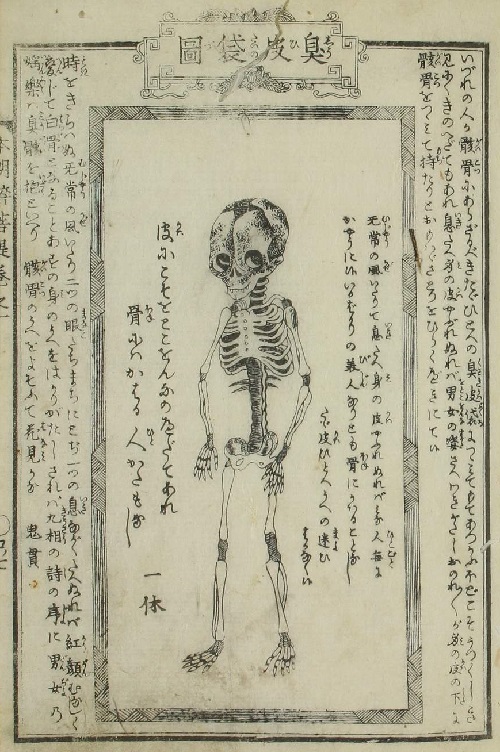
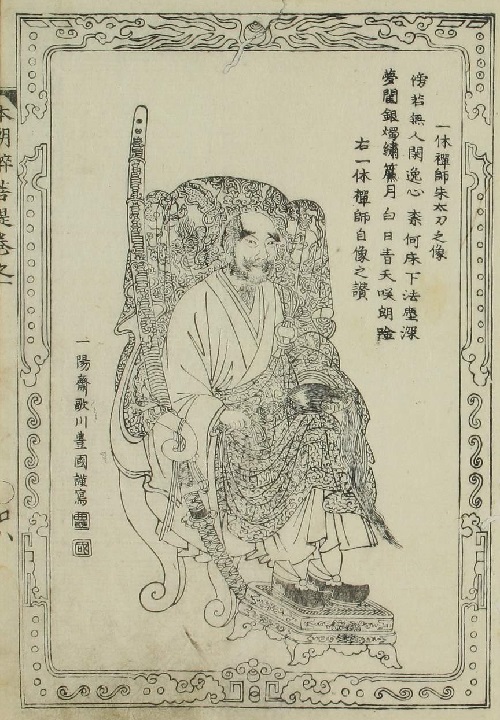
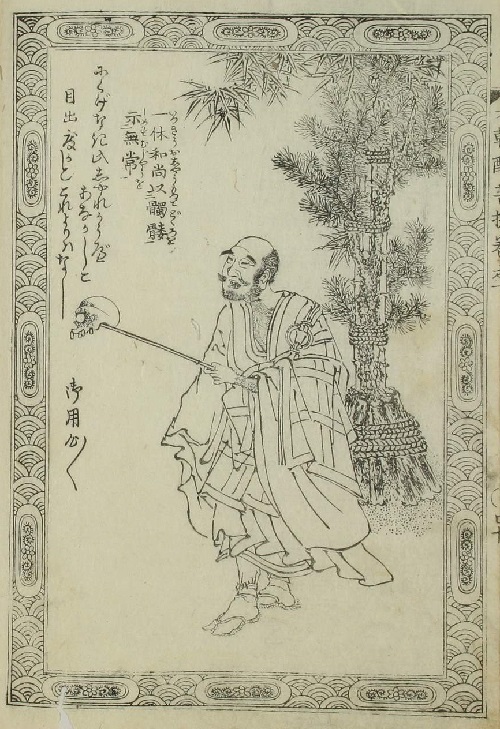
Image of the priest Ikkyu carrying a skull
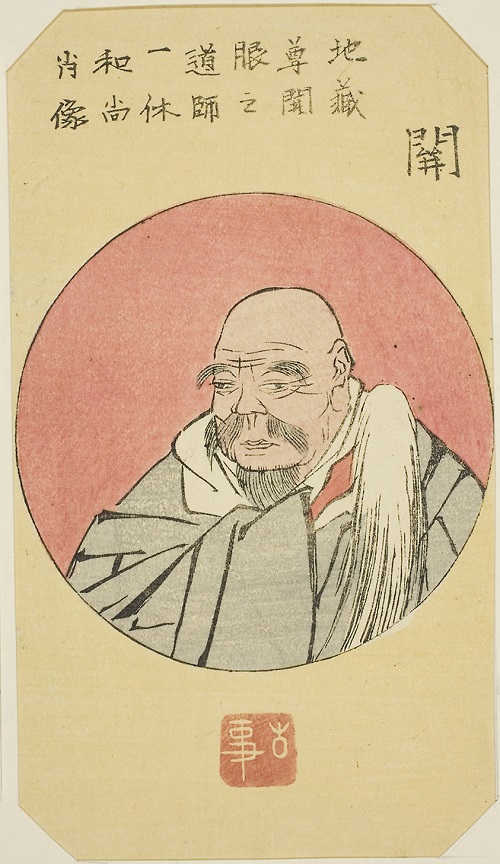
Seki: Portrait of Ikkyu (Seki, Ikkyu Osho shozo),
section of sheet no. 12 from the series "Cutouts of the Fifty-three Stations (Gojusan tsugi harimaze)"
Date: 1852
by 歌川 広重 Utagawa Hiroshige (1797-1858)
Color woodblock print; section of harimaze sheet, 17 x 9.6 cm

Painting by 白隠慧鶴 Hakuin Ekaku (1686-1769)

Zen Skull & Ikkyu's Poem by 山岡鉄舟 Yamaoka Tesshū (1836-1888)
"Don't be scared
Of this weather beaten
Abandoned old skull;
It is a matter of congratulation
Better than any other!"
(Nikugenaki kono share [koube] anakashiko
medetakaku kashiku kore yori wa nashi)
On New Year's Day, the famous Zen master Ikkyu walked around the town brandishing a human skull while shouting, "Beware, beware!"
When asked why he would do such a thing on a day of celebration, Ikkyu recited the above Zen verse. If there is death there must have been life.
That is a matter of congratulation; but since life will end as death, don't waste your time on frivolous pursuits.
In short, "Live completely, die completely!", Tesshu's motto.
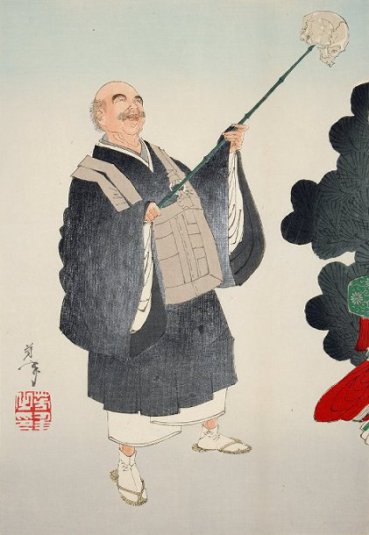
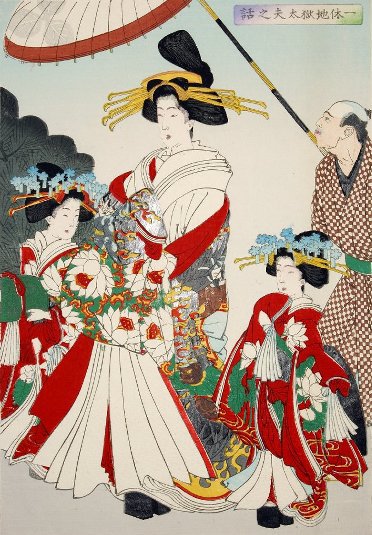
The Buddhist monk Ikkyu holding a skull before the courtesan Jigoku-dayu (Jigoku Reigan),
diptych print (1886) by 月岡芳年 Tsukioka Yoshitoshi (1839-1892)
British Museum collection
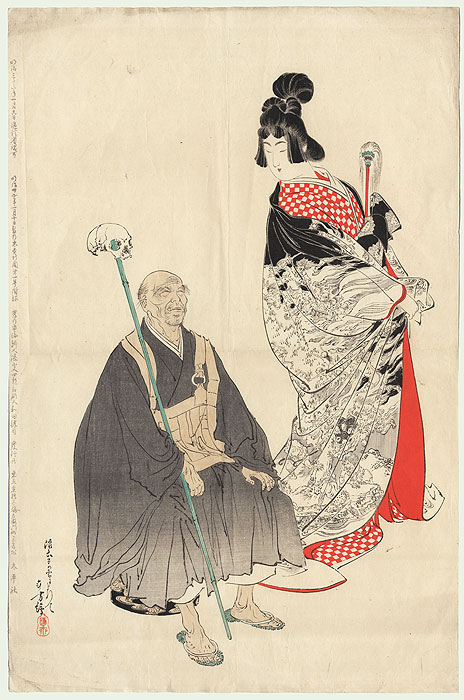
The Courtesan Jigoku-dayu and Priest Ikkyu, 1899, by 水野年方 Mizuno Toshikata (1866-1908)
Known for carrying a staff topped with a skull to remind New Year's Day revelers of the inevitability of death,
Ikkyu enlightened the young courtesan as to the evils of her profession, and she became a convert to religious life.
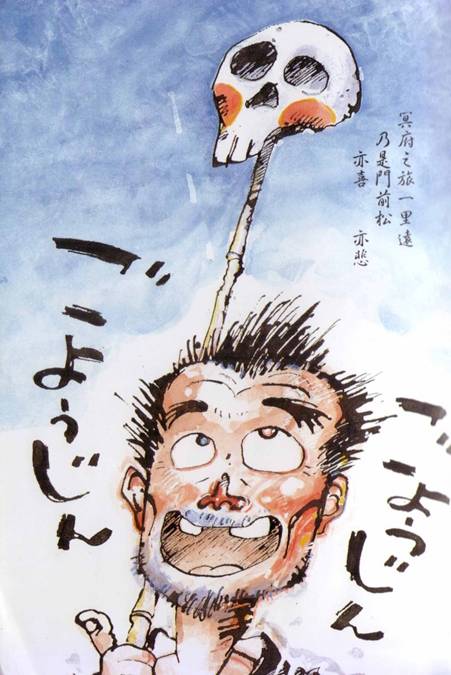
The Japanese manga author 坂口尚 Hisashi Sakaguchi (1946-1995) wrote a life story of Ikkyu, あっかんべェ一休, 'Ikkyu', or 'Akkanbe Ikkyu',
more or less according to the popular stories about him. The manga has been translated in four volumes into Catalan, Spanish, French, German and Italian.
In English:
vol. 1, chapter 1-4.
vol. 2, chapter 5-8.
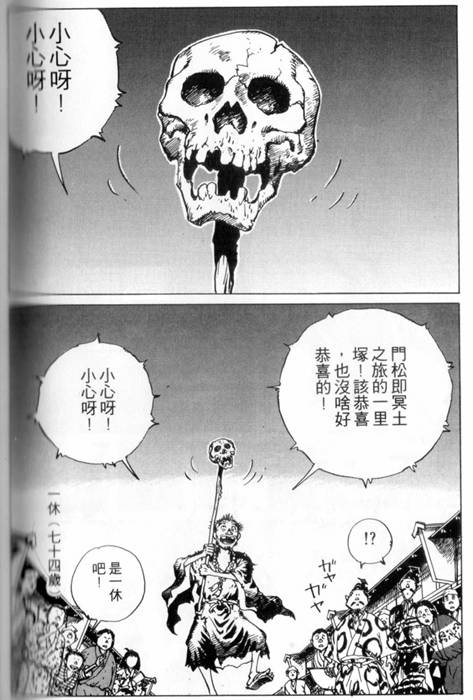
PDF: Scheletri tra Oriente e Occidente: Danse macabre e Ikkyu gaikotsu
Imanishi Yūichirō
Associazione Italiana per gli Studi Giapponesi
Volume Convegno AISTUGIA Roma 2013
Collana di Studi Giapponesi, Ricerche 3, 2014, pp. 385-396.